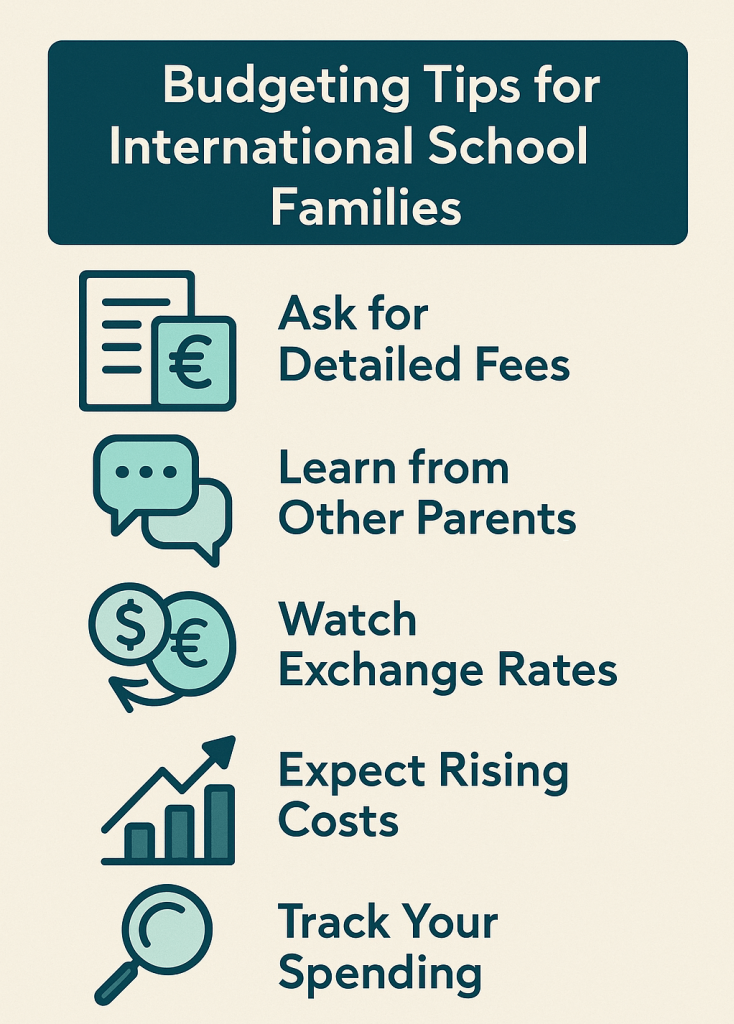When exploring international schools for your child, tuition is usually the first number that grabs your attention. But as many families soon discover, it’s far from the only cost. From application fees and uniforms to transport, lunches, and extracurriculars, the real cost of schooling often stretches well beyond what’s listed in the brochure.
This guide helps you plan with confidence. We break down the most common hidden expenses that come with international schooling and offer practical budgeting tips to avoid unexpected strain. Whether you’re preparing for your first enrollment or reviewing your family’s long-term education plan, understanding the full financial picture is key to making informed, sustainable decisions.
What’s Included (and What’s Not) in Tuition
Commonly Covered Costs
Most international schools include core academic instruction and access to school facilities within their tuition fees. This typically covers classroom teaching, library use, some digital platforms, and general school administration. In some cases, standard co-curricular activities during school hours may also be included.
Typical Exclusions
However, many everyday essentials are charged separately. Items such as uniforms, school meals, transport services, and personal learning devices often fall outside the tuition package. Even co-curricular clubs, exam fees, or additional academic support may come with added costs. It’s important to clarify early on what’s covered and what isn’t, so you’re not caught off guard mid-term.
Hidden and Often Overlooked Expenses
One-Time & Recurring Fees
Many international schools charge additional fees that aren’t always obvious at first glance. These can include application fees, registration deposits, building levies, and annual capital fees. Some may be due upfront, while others reappear each academic year.
Uniforms, Supplies, and Technology
Branded uniforms, sports kits, and seasonal wear can add up quickly, especially as children grow. You’ll also need to budget for items like stationery, textbooks, and in some cases, laptops or tablets required by the school.

Meals and Transport
School lunch programmes, snacks, and bus services are often charged separately. Depending on your child’s age and your location, these recurring expenses can significantly impact your monthly budget.
Trips and Events
Whether it’s a local museum visit, overnight camp, or international cultural exchange, school trips can carry extra costs. Some may be optional, but others, particularly residential or curriculum-linked trips, are required. Always ask how many are planned per year and whether they’re included in the term fee.
Planning for Additional Services
After-School Activities and Clubs
While many schools offer extracurriculars, specialised programmes such as robotics, music lessons, sports coaching, or language clubs often come with added fees. These can be billed per term or per session and vary widely depending on the school.
Learning Support and Specialist Services
If your child needs extra academic support, English as an Additional Language (EAL), or access to services like speech therapy or counselling, these are often charged separately. It’s essential to check what’s included in general tuition and what may fall under optional or specialist care.
Exams and University Preparation
Secondary school costs can rise with exam fees for IGCSEs, IB, A-Levels, or SATs. Some schools also offer university prep programmes or counselling services that may involve additional payments, particularly for overseas application processes.
How to Build a Realistic Budget
Request a Full Fee Breakdown
Start by asking the school for a detailed breakdown of both required and optional costs. Some schools provide transparent estimates by year level, including expected fees for uniforms, trips, meals, and learning materials.
Talk to Other Parents
Current or former parents can offer valuable insights into actual costs, especially those that aren’t listed on the school’s website. Their experiences can help you avoid surprises and plan more accurately.
Consider Currency and Cost Increases
If you’re paying in a foreign currency or living in a region with variable inflation, factor in potential changes over time. It’s also wise to plan for higher costs as your child progresses into secondary or exam years, where fees and extra services often increase.

Smart Ways to Manage Costs
Prioritise High-Value Extras
Not every activity or service needs to be part of your plan. Focus on those that genuinely support your child’s interests or academic growth. This might mean selecting one or two enrichment activities per term rather than signing up for everything available.
Track Spending and Look for Savings
Use a simple spreadsheet or budgeting app to monitor education-related expenses across the year. Check if the school offers sibling discounts, referral incentives, or financial aid programmes. Even small savings, like bringing lunch from home or buying uniforms secondhand, can add up over time.
Planning for Peace of Mind
Choosing an international school is a meaningful investment, but understanding the full cost is essential for making a confident, long-term decision. When families plan beyond tuition, factoring in uniforms, transport, enrichment, and occasional surprises, they’re better prepared for the true financial picture.
By requesting clear breakdowns, learning from other parents, and tracking expenses, you can stay in control of your education budget. With thoughtful planning and the right support, your child can enjoy a rich, well-rounded international school experience without unexpected financial pressure. For school fee comparisons, budgeting tools, and trusted insights, explore the parent resources available on AISL Mall.










